Module 6 Around town复习课件2022-2023学年七年级英语下册单元复习(共47张PPT)
文档属性
| 名称 | Module 6 Around town复习课件2022-2023学年七年级英语下册单元复习(共47张PPT) | 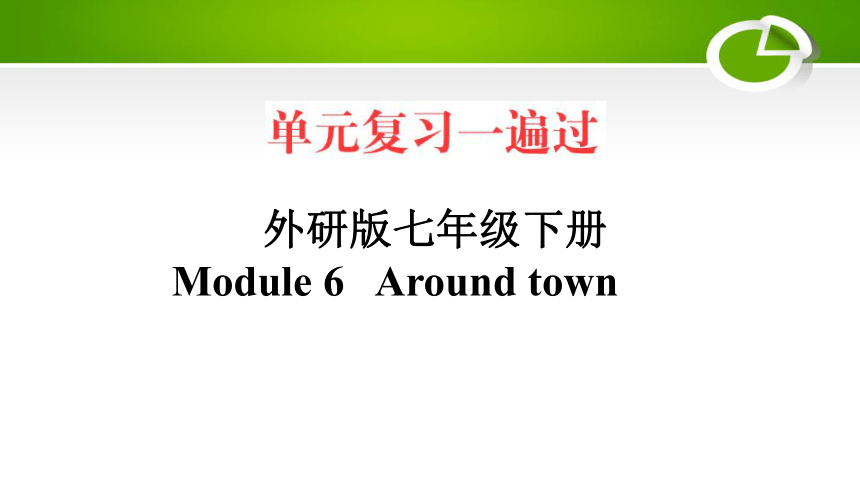 | |
| 格式 | pptx | ||
| 文件大小 | 42.9MB | ||
| 资源类型 | 教案 | ||
| 版本资源 | 外研版 | ||
| 科目 | 英语 | ||
| 更新时间 | 2023-03-12 14:23:39 | ||
图片预览

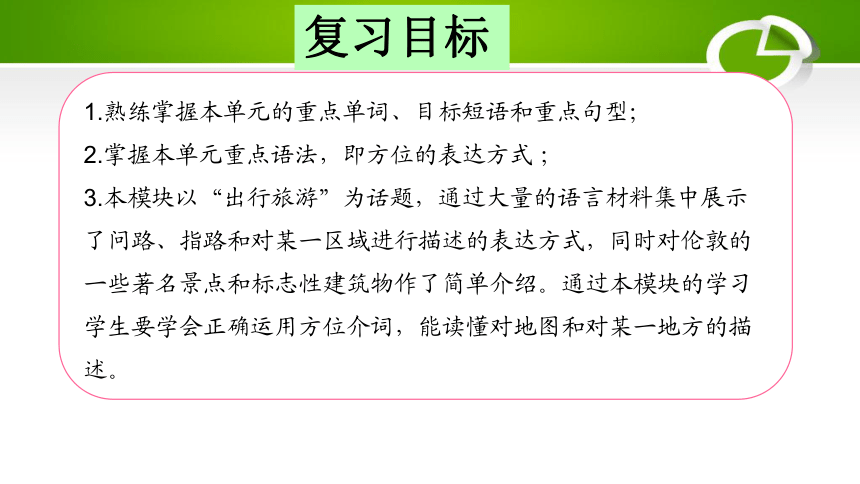
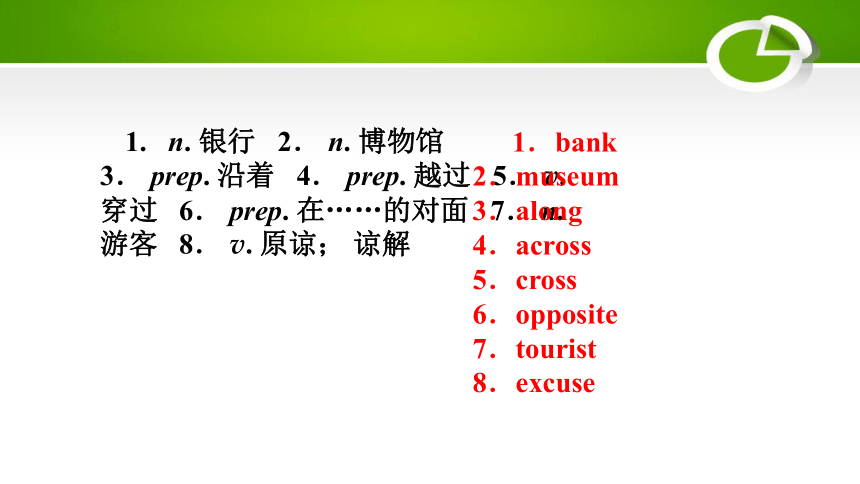
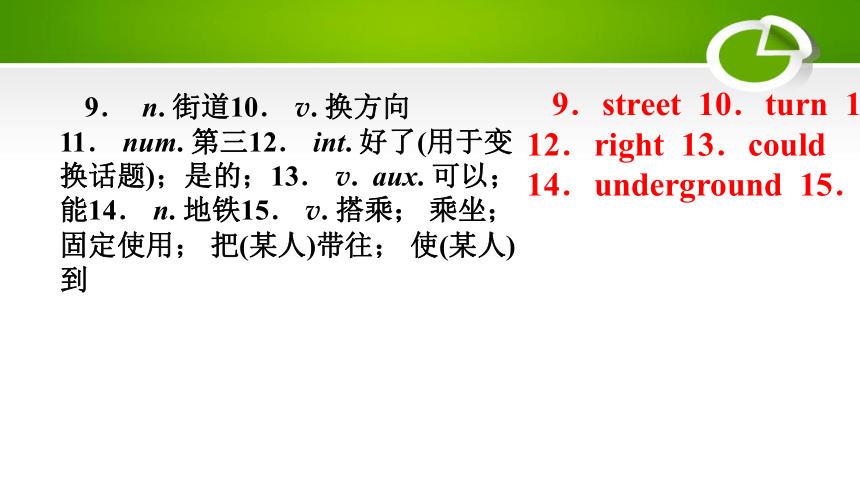
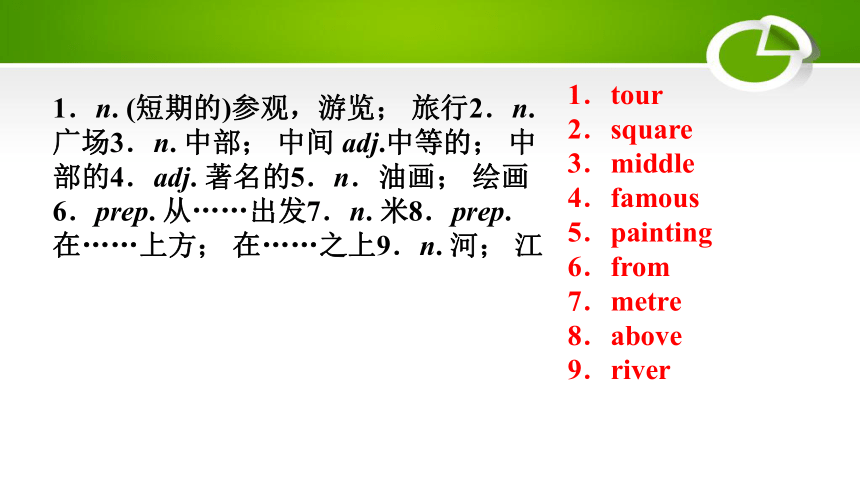
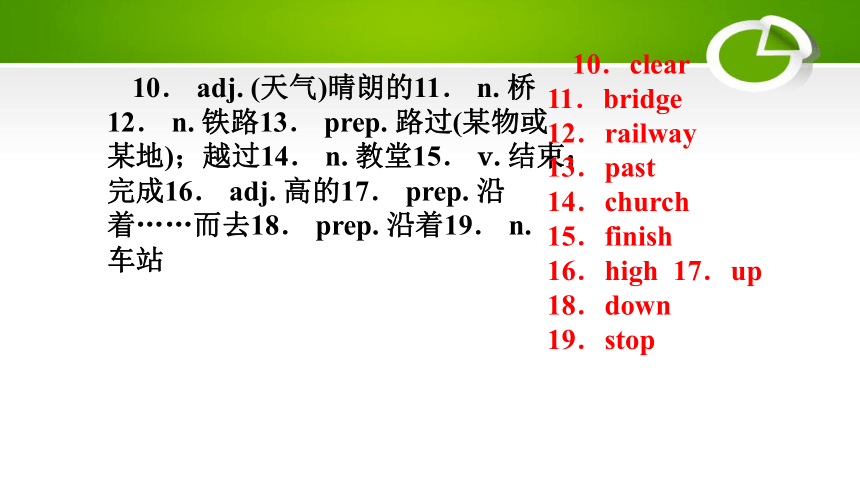
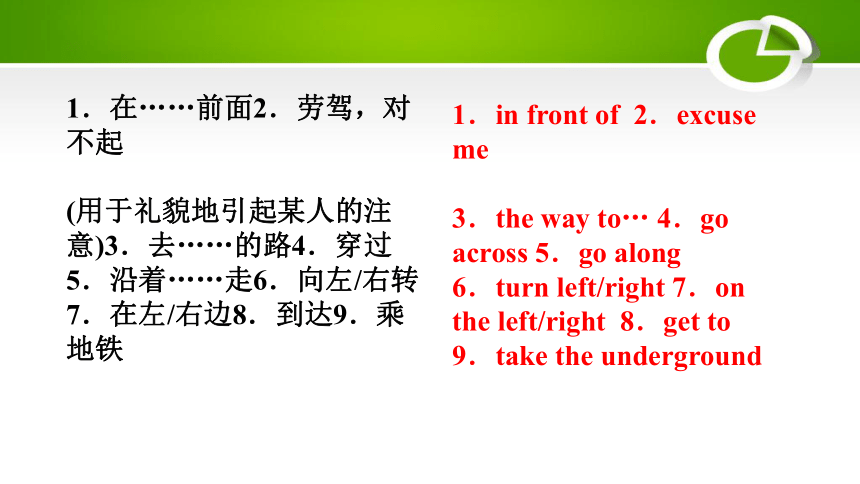
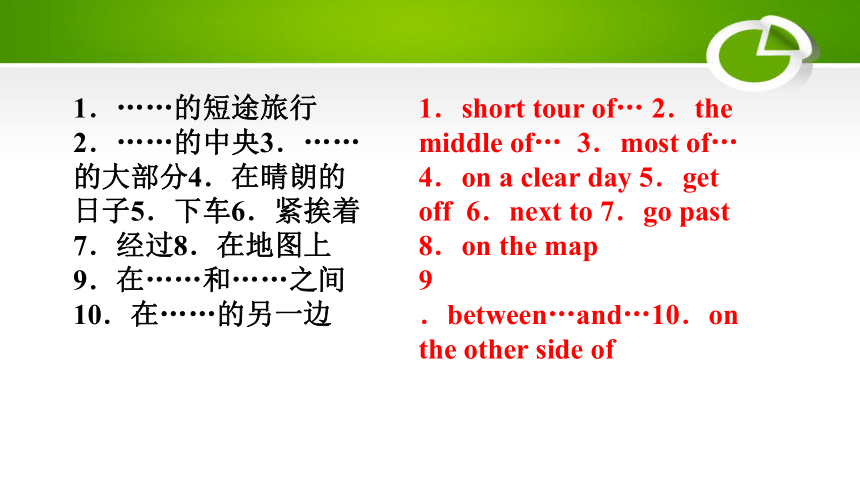

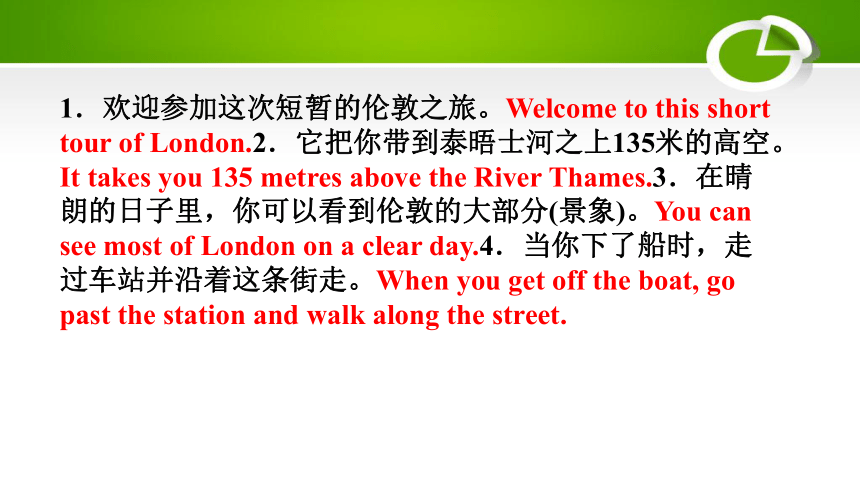
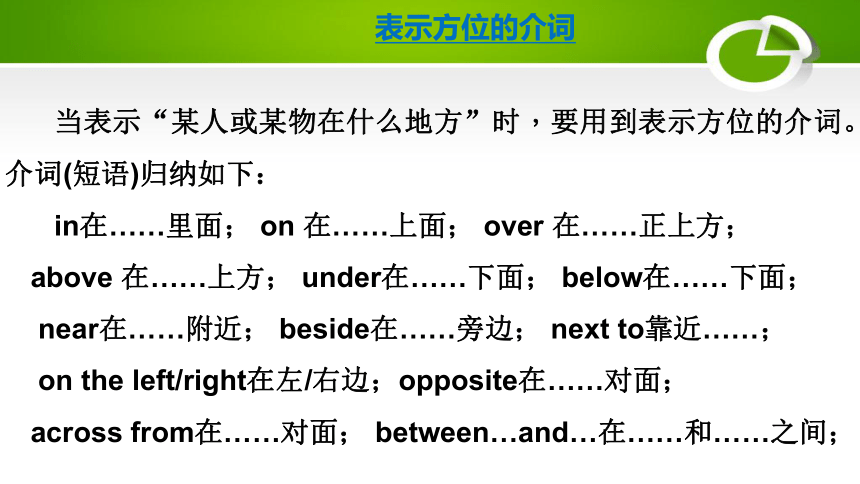
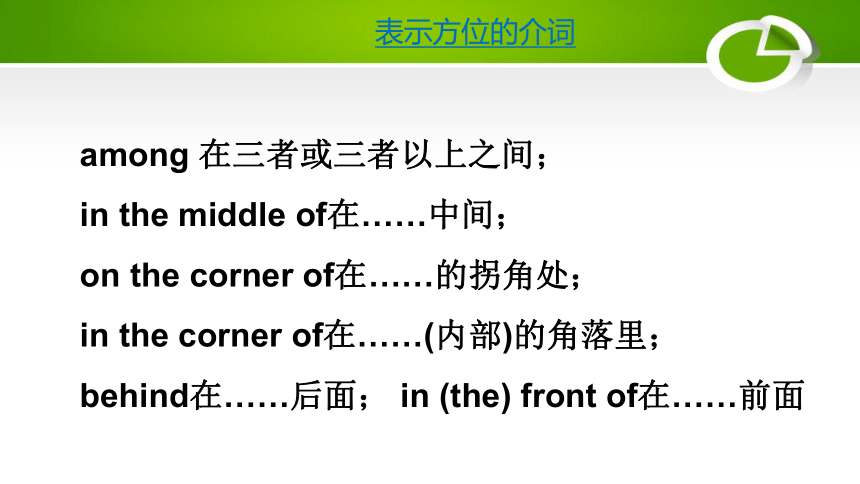
文档简介
(共47张PPT)
外研版七年级下册
Module 6 Around town
1.熟练掌握本单元的重点单词、目标短语和重点句型;
2.掌握本单元重点语法,即方位的表达方式 ;
3.本模块以“出行旅游”为话题,通过大量的语言材料集中展示了问路、指路和对某一区域进行描述的表达方式,同时对伦敦的一些著名景点和标志性建筑物作了简单介绍。通过本模块的学习学生要学会正确运用方位介词,能读懂对地图和对某一地方的描述。
复习目标
1. n. 银行 2. n. 博物馆 3. prep. 沿着 4. prep. 越过 5. v. 穿过 6. prep. 在……的对面 7. n. 游客 8. v. 原谅; 谅解
1.bank 2.museum 3.along 4.across 5.cross 6.opposite 7.tourist 8.excuse
9. n. 街道10. v. 换方向11. num. 第三12. int. 好了(用于变换话题);是的;13. v. aux. 可以; 能14. n. 地铁15. v. 搭乘; 乘坐; 固定使用; 把(某人)带往; 使(某人)到
9.street 10.turn 11.third 12.right 13.could 14.underground 15.take
1.n. (短期的)参观,游览; 旅行2.n. 广场3.n. 中部; 中间 adj.中等的; 中部的4.adj. 著名的5.n.油画; 绘画6.prep. 从……出发7.n. 米8.prep. 在……上方; 在……之上9.n. 河; 江
1.tour 2.square 3.middle 4.famous 5.painting 6.from 7.metre 8.above 9.river
10. adj. (天气)晴朗的11. n. 桥12. n. 铁路13. prep. 路过(某物或某地);越过14. n. 教堂15. v. 结束; 完成16. adj. 高的17. prep. 沿着……而去18. prep. 沿着19. n. 车站
10.clear 11.bridge 12.railway 13.past 14.church 15.finish 16.high 17.up 18.down 19.stop
1.在……前面2.劳驾,对不起
(用于礼貌地引起某人的注意)3.去……的路4.穿过5.沿着……走6.向左/右转7.在左/右边8.到达9.乘地铁
1.in front of 2.excuse me
3.the way to… 4.go across 5.go along 6.turn left/right 7.on the left/right 8.get to 9.take the underground
1.……的短途旅行2.……的中央3.……的大部分4.在晴朗的日子5.下车6.紧挨着7.经过8.在地图上9.在……和……之间10.在……的另一边
1.short tour of… 2.the middle of… 3.most of… 4.on a clear day 5.get off 6.next to 7.go past 8.on the map 9.between…and…10.on the other side of
1.打扰一下!你能告诉我去王府井大街的路吗?Excuse me! Can you tell me the way to Wangfujing Dajie 2.穿过东长安街,沿着这条街走并且在左边第三条街向左转。Go across Dong Chang'an Jie, go along the street and turn left at the third street on the left.3.这附近有书店吗?Is there a bookshop near here 4.为什么不问一下那边的那位警察呢?Why not ask the policeman over there 5.你能告诉我怎样到达国家体育场吗?Could you tell me how to get to the National Stadium 6. 玩得愉快!
Have a nice day!
1.欢迎参加这次短暂的伦敦之旅。Welcome to this short tour of London.2.它把你带到泰晤士河之上135米的高空。It takes you 135 metres above the River Thames.3.在晴朗的日子里,你可以看到伦敦的大部分(景象)。You can see most of London on a clear day.4.当你下了船时,走过车站并沿着这条街走。When you get off the boat, go past the station and walk along the street.
表示方位的介词
当表示“某人或某物在什么地方”时,要用到表示方位的介词。常见的方位介词(短语)归纳如下:
in在……里面; on 在……上面; over 在……正上方;
above 在……上方; under在……下面; below在……下面;
near在……附近; beside在……旁边; next to靠近……;
on the left/right在左/右边;opposite在……对面;
across from在……对面; between…and…在……和……之间;
表示方位的介词
among 在三者或三者以上之间;
in the middle of在……中间;
on the corner of在……的拐角处;
in the corner of在……(内部)的角落里;
behind在……后面; in (the) front of在……前面
表示方位的介词
( )1.2018·包头—Are you watching the football matches of the World Cup these days
—Sometimes, and I'll watch the match ________ Japan and Poland tonight.
A.against B.about
C.through D.between
[解析]考查介词的用法。against意为“反对,对……不利”;about意为“关于”;through意为“透过,通过”;between意为“在……(两者)之间”。分析句意可推知,这场比赛是日本和波兰之间进行的,故选D。
D
表示方位的介词
( )2. The old man is a good swimmer, and even
now he often swims ________ Tuojiang River after
supper.
over B. through C. to D. across
D
1.Our house is________________(在……右边) the park.
2.There is a museum___________________ (在……对面)
the square.
3.There is a big library___________ (紧挨着) our school.
4.The teacher is standing____________(在…中间) the
classroom.
5.The shop is________________(在……另一边) the street.
on the right of
opposite/across from
next to
in the middle of
on the other side of
表示方位的介词
1. Excuse me, Can you tell me the way to Wangfujing Dajie
excuse me 打扰一下, 请原谅, 劳驾
Excuse me, could you let me through
Did I step on your toes Sorry!
excuse me 主要用于请别人帮忙或打扰别人时, 是表示客套的话.
sorry adj 遗憾的; 对不起的, 抱歉的
主要用于自己犯了某种错误而道歉, 也可用于表示不同意或委婉地拒绝.
考点精讲
the way to sp 去…的路
1)the 可以用物主代词替换.
2)如果表示地点的词是home, there, here等副词时, 则不用介词to.
I see some beautiful flowers on my way home.
= I see some beautiful flowers on the way to my home.
on one’s way to sp 在去…的路上
You’ll meet with many difficulties on your way to success.
2. Go across Dong Chang'an Jie, go along the street and turn left at the third street on the left.
指路用语:
go across … 穿过…=cross(vt.)
go/walk along … 沿着…走
go straight ahead … 径直向前走
go down… 沿着(指下坡)
go up… 沿着(指上坡)
go past… 经过…=pass(vt.)
across VS cross
(1) Go across Dong Chang'an Jie.
= Cross Dong Chang'an Jie.
(2) It’s dangerous to run across the street.
= It’s dangerous to cross the street by running.
(3) Please be careful when you cross the street.
=Please be careful when you go across the street.
across prep (在表面)越过, 横穿
cross vt 穿过, 横穿 v + across + sth = cross sth
3. turn vt. 转弯
turn left / right 左转、右转
Turn left into Chang'an Jie and turn right into Chang Jie.
turn left / right into …左/ 右转到/进入…
Turn left at the third street/turning.
turn left / right at … 在…左/ 右转
on the left / right 在左/右边
on sb’s left / right 在…的左/ 右边
on the left / right of… 在…的左/右边
4. … on the right, opposite the bank.
opposite prep 在…的对面
相当于across from, 常与名词短语连用表方位.
The store is opposite/ across from the station.
He stands opposite me.
opposite adj 对面的;相反的
Answers are on the opposite page.
He is running in the opposite direction.
4. … on the right, opposite the bank.
opposite prep 在…的对面
相当于across from, 常与名词短语连用表方位.
The store is opposite/ across from the station.
He stands opposite me.
opposite adj 对面的;相反的
Answers are on the opposite page.
He is running in the opposite direction.
常用的表方位的介词短语:
on the left/right 在左边/右边
next to 与…紧挨着
on the corner (of…) 在(…的)拐角处
between …and… 在…和…之间
in front of/behind 在…前面/后面
5. How can I get there
get to sp 到达某地
接副词时(here, there, home)不用加介词
How can I get to Leshan
He usually gets home at 6.
arrive in+大地点
arrive at+小地点
5. How can I get there
get to sp 到达某地
接副词时(here, there, home)不用加介词
How can I get to Leshan
He usually gets home at 6.
arrive in+大地点
arrive at+小地点
接副词时(here, there, home)不用加介词
— When will he arrive in Leshan
— He is arriving there in three days
reach vt reach sp 到达某地
When will he reach Leshan
注意: 若只表到达,没有具体地点时只 用arrive.
When will he arrive
5. Why not ask the policeman over there
Why not do sth = Why don't/doesn't sb do sth
为什么不做某事 (= Why don't you ask the policeman over there )
为什么不在下午去野餐呢
(1) Why not have a picnic this afternoon
(2) Why don't we have a picnic this afternoon
表提建议的句型还有:
Shall we (do)… 我们(做)…怎么样 What about (doing)… (做)…怎么样 Let's (do)… 咱们(做)… You'd better (do)你最好(做)…
6. Could you tell me how to get to the National Stadium
不定式短语: 疑问词 + to do 在句子中可作主语、宾语、表语等.
She didn't know which bus to take.
I don’t know what to say.
I don’t know how to say it.
He will tell us where to meet and when to leave.
问路的句型:
Could/Can you tell me the way to…
Could/Can you tell me how to get to/how I can get to……
Where is…
Is there a(n) …near here
How can I get / go to…
Do you know the way to…
Can you show me the way to…
交通方式的表达
用介词
walk/ride/fly/drive + to + sp
go to sp by + 交通工具
go to sp in/on + 限定词 + 工具
6. 交通方式的表达
7. Welcome to this short tour of London.
tour; travel; trip; journey
tour 旅行, 周游, 观光. 主要指游览或视察, 距离可长可短
go on a tour to Europe 去…旅行
travel 一般指长途旅行, 或到国外或远方旅行.
Nowadys,many people are fond of travel in their spare time.
trip 一般指短距离旅行, 直达目的地的旅行.
be on a school trip/ be on a business trip
journey 主要指单程较远距离的海陆空"旅行", 去旅行 go on a journey.
8. We are standing opposite the National Gallery , a museum with lots of famous paintings.
a museum 是the National Gallery 的同位语, with 引导的介词短语修饰museum.
famous adj 出名的 = well-known
(1) France is famous for its wine.
(2) Yaoming is famous as a basketball player.
be famous for 以…出名或著称 be famous as 作为…出名或著称
as is known to all=as we all know 众所周知
9. It takes you 135 meters above the River Thames.
above prep 在…之上
There is a picture above the bookshelf.
above; over; on
(1) The plane is flying above the clouds.
(2) There is a bridge over the river.
(3) There is a pencil on the desk.
on
over
above
beneath
below
under
10. You can see most of London on a clear day.
clear adj 晴朗的, 清晰的; 清洁的.
(1) It's a clear day today.
(2) The river has clear water.
(3) Please clear the table before meals.
vt 清理干净
(4) We can see the clouds clearly.
派生词: clearly adv 清晰地
构词法: adj + -ly adv
11. The best way to see London is by boat.
the best way to do/of doing sth 做…的最好方式
Her bike was broken on her way to school.
on sb's/the way to sp 在去…的路上
By the way, do you know where Mary lives
by the way 顺便说一下
I'm afraid your car is in the way.
in the way 挡路
12. As you go along the river, the London Eye is on your right.
as conj 当…之时; 随着…; 正如, 如同
在此句中引导时间状语从句 = when.
as 的其它用法
1) conj 因为…
I think we should stay at home as it looks like rain.
2) prep 作为…
As a teacher, it is my duty to help students to achieve their dreams.
3)adv 像…一样 常用于比较.
Harry is busy, but his wife is just as busy as Harry.
13. 方位介词用法
介词又称为前置词, 它不能单独作句子的成分, 必须与名词、代词或相当于名词的其他结构构成介词短语才能充当句子成分. 表示位置关系的介词叫方位介词.
at, in 在…
(1) at the bus stop, at home
(2) in China, in the world
at表示较小的地点, in表示较大的地点.
through / across 通过, 穿过
across 横过, 从物体表面通过, 与on 有关, 为二维.
through 穿过, 从物体内部穿过, 与in 有关, 为三维.
in front of 和in the front of
1.There are some trees in front of the house.
in front of 在…前面(范围外)
2.There is a blackboard in the front of the classroom.
in the front of 在…的前部(范围内)
in 和on 表示"在…上"
1. 镶嵌在墙里的, 如门、钉子一类用in,
挂在墙面上的, 字画一类用on.
2. 鸟一类落在树上的, 用in;
苹果一类长在树上的, 用on.
in /on/ to表示方位
(1) Shanghai lies in the east of China.
(2) Japan lies to the east of China.
(3) Russia lies on the north of China.
in 表示在某范围之内;
to 表示在某范围之外;
on 表示"邻"、"接壤”.
本模块以“出行旅游”为话题,通过大量的语言材料集中
展示了问路、指路和对某一区域进行描述的表达方式,同时
对伦敦的一些著名景点和标志性建筑物作了简单介绍。通过
本模块的学习,学生要学会正确运用方位介词,能读懂对地
图和对某一地方的描述。
写 作 案 例
假设你是肖伟,你的新同学Mike刚搬到你所在城市
的某个小区,他想去电影院看电影,但不知道路。
请你用英语给他写一封60词左右的电子邮件,告诉他
去电影院的路。
destination
turn left /right into...
go along/up/down/past/across...
Take a bus/taxi
素 材 积 累
词汇
1.穿过________________
2.沿着________________
3.在……的对面 ________________
4.向左/右拐________________
5.乘坐地铁/公交车/出租车________________
cross/go across
along/down/up
opposite/across from
turn left/right
take the underground/a bus/
a taxi/by under ground/bus/taxi
素 材 积 累
6.旅行________________
7.晴朗的________________
8.车站________________
9.到达________________
10.玩得开心________________
tour
clear
stop
get to
have a nice/good day
素 材 积 累
句型
1.Excuse me! Can you tell me the way to…?
2.Go across…, go along…and turn left/right at…
3.The…is opposite…
4.…is between…and…
5.Tahe best way to…is…
范文赏析
Dear Mike,
①Let me tell you the way to the cinema. It's not far ②from
your house. Walk out of your house, turn right and go along Zhonghua
Road. Walk till you reach a bridge. After you go across the bridge,
turn right into Xiaoqiang Street. Then walk along the street, and
turn left at the second turning.
And you will see a shop on your left. Walk past the shop, and
you can see the cinema.
③Good luck!
Yours,
Xiao Wei
①第一句话简单明了,点明这是一封介绍路线的电子邮件。
②详细介绍路线时,恰当使用了from, along, across, into, past等介词,
令路线的介绍非常清晰;then及祈使句的使用,既使行文流畅,又增强了
文章的可读性。
③以简短的两个单词结尾,表达了美好的祝愿,照应了文章的开头。
外研版七年级下册
Module 6 Around town
1.熟练掌握本单元的重点单词、目标短语和重点句型;
2.掌握本单元重点语法,即方位的表达方式 ;
3.本模块以“出行旅游”为话题,通过大量的语言材料集中展示了问路、指路和对某一区域进行描述的表达方式,同时对伦敦的一些著名景点和标志性建筑物作了简单介绍。通过本模块的学习学生要学会正确运用方位介词,能读懂对地图和对某一地方的描述。
复习目标
1. n. 银行 2. n. 博物馆 3. prep. 沿着 4. prep. 越过 5. v. 穿过 6. prep. 在……的对面 7. n. 游客 8. v. 原谅; 谅解
1.bank 2.museum 3.along 4.across 5.cross 6.opposite 7.tourist 8.excuse
9. n. 街道10. v. 换方向11. num. 第三12. int. 好了(用于变换话题);是的;13. v. aux. 可以; 能14. n. 地铁15. v. 搭乘; 乘坐; 固定使用; 把(某人)带往; 使(某人)到
9.street 10.turn 11.third 12.right 13.could 14.underground 15.take
1.n. (短期的)参观,游览; 旅行2.n. 广场3.n. 中部; 中间 adj.中等的; 中部的4.adj. 著名的5.n.油画; 绘画6.prep. 从……出发7.n. 米8.prep. 在……上方; 在……之上9.n. 河; 江
1.tour 2.square 3.middle 4.famous 5.painting 6.from 7.metre 8.above 9.river
10. adj. (天气)晴朗的11. n. 桥12. n. 铁路13. prep. 路过(某物或某地);越过14. n. 教堂15. v. 结束; 完成16. adj. 高的17. prep. 沿着……而去18. prep. 沿着19. n. 车站
10.clear 11.bridge 12.railway 13.past 14.church 15.finish 16.high 17.up 18.down 19.stop
1.在……前面2.劳驾,对不起
(用于礼貌地引起某人的注意)3.去……的路4.穿过5.沿着……走6.向左/右转7.在左/右边8.到达9.乘地铁
1.in front of 2.excuse me
3.the way to… 4.go across 5.go along 6.turn left/right 7.on the left/right 8.get to 9.take the underground
1.……的短途旅行2.……的中央3.……的大部分4.在晴朗的日子5.下车6.紧挨着7.经过8.在地图上9.在……和……之间10.在……的另一边
1.short tour of… 2.the middle of… 3.most of… 4.on a clear day 5.get off 6.next to 7.go past 8.on the map 9.between…and…10.on the other side of
1.打扰一下!你能告诉我去王府井大街的路吗?Excuse me! Can you tell me the way to Wangfujing Dajie 2.穿过东长安街,沿着这条街走并且在左边第三条街向左转。Go across Dong Chang'an Jie, go along the street and turn left at the third street on the left.3.这附近有书店吗?Is there a bookshop near here 4.为什么不问一下那边的那位警察呢?Why not ask the policeman over there 5.你能告诉我怎样到达国家体育场吗?Could you tell me how to get to the National Stadium 6. 玩得愉快!
Have a nice day!
1.欢迎参加这次短暂的伦敦之旅。Welcome to this short tour of London.2.它把你带到泰晤士河之上135米的高空。It takes you 135 metres above the River Thames.3.在晴朗的日子里,你可以看到伦敦的大部分(景象)。You can see most of London on a clear day.4.当你下了船时,走过车站并沿着这条街走。When you get off the boat, go past the station and walk along the street.
表示方位的介词
当表示“某人或某物在什么地方”时,要用到表示方位的介词。常见的方位介词(短语)归纳如下:
in在……里面; on 在……上面; over 在……正上方;
above 在……上方; under在……下面; below在……下面;
near在……附近; beside在……旁边; next to靠近……;
on the left/right在左/右边;opposite在……对面;
across from在……对面; between…and…在……和……之间;
表示方位的介词
among 在三者或三者以上之间;
in the middle of在……中间;
on the corner of在……的拐角处;
in the corner of在……(内部)的角落里;
behind在……后面; in (the) front of在……前面
表示方位的介词
( )1.2018·包头—Are you watching the football matches of the World Cup these days
—Sometimes, and I'll watch the match ________ Japan and Poland tonight.
A.against B.about
C.through D.between
[解析]考查介词的用法。against意为“反对,对……不利”;about意为“关于”;through意为“透过,通过”;between意为“在……(两者)之间”。分析句意可推知,这场比赛是日本和波兰之间进行的,故选D。
D
表示方位的介词
( )2. The old man is a good swimmer, and even
now he often swims ________ Tuojiang River after
supper.
over B. through C. to D. across
D
1.Our house is________________(在……右边) the park.
2.There is a museum___________________ (在……对面)
the square.
3.There is a big library___________ (紧挨着) our school.
4.The teacher is standing____________(在…中间) the
classroom.
5.The shop is________________(在……另一边) the street.
on the right of
opposite/across from
next to
in the middle of
on the other side of
表示方位的介词
1. Excuse me, Can you tell me the way to Wangfujing Dajie
excuse me 打扰一下, 请原谅, 劳驾
Excuse me, could you let me through
Did I step on your toes Sorry!
excuse me 主要用于请别人帮忙或打扰别人时, 是表示客套的话.
sorry adj 遗憾的; 对不起的, 抱歉的
主要用于自己犯了某种错误而道歉, 也可用于表示不同意或委婉地拒绝.
考点精讲
the way to sp 去…的路
1)the 可以用物主代词替换.
2)如果表示地点的词是home, there, here等副词时, 则不用介词to.
I see some beautiful flowers on my way home.
= I see some beautiful flowers on the way to my home.
on one’s way to sp 在去…的路上
You’ll meet with many difficulties on your way to success.
2. Go across Dong Chang'an Jie, go along the street and turn left at the third street on the left.
指路用语:
go across … 穿过…=cross(vt.)
go/walk along … 沿着…走
go straight ahead … 径直向前走
go down… 沿着(指下坡)
go up… 沿着(指上坡)
go past… 经过…=pass(vt.)
across VS cross
(1) Go across Dong Chang'an Jie.
= Cross Dong Chang'an Jie.
(2) It’s dangerous to run across the street.
= It’s dangerous to cross the street by running.
(3) Please be careful when you cross the street.
=Please be careful when you go across the street.
across prep (在表面)越过, 横穿
cross vt 穿过, 横穿 v + across + sth = cross sth
3. turn vt. 转弯
turn left / right 左转、右转
Turn left into Chang'an Jie and turn right into Chang Jie.
turn left / right into …左/ 右转到/进入…
Turn left at the third street/turning.
turn left / right at … 在…左/ 右转
on the left / right 在左/右边
on sb’s left / right 在…的左/ 右边
on the left / right of… 在…的左/右边
4. … on the right, opposite the bank.
opposite prep 在…的对面
相当于across from, 常与名词短语连用表方位.
The store is opposite/ across from the station.
He stands opposite me.
opposite adj 对面的;相反的
Answers are on the opposite page.
He is running in the opposite direction.
4. … on the right, opposite the bank.
opposite prep 在…的对面
相当于across from, 常与名词短语连用表方位.
The store is opposite/ across from the station.
He stands opposite me.
opposite adj 对面的;相反的
Answers are on the opposite page.
He is running in the opposite direction.
常用的表方位的介词短语:
on the left/right 在左边/右边
next to 与…紧挨着
on the corner (of…) 在(…的)拐角处
between …and… 在…和…之间
in front of/behind 在…前面/后面
5. How can I get there
get to sp 到达某地
接副词时(here, there, home)不用加介词
How can I get to Leshan
He usually gets home at 6.
arrive in+大地点
arrive at+小地点
5. How can I get there
get to sp 到达某地
接副词时(here, there, home)不用加介词
How can I get to Leshan
He usually gets home at 6.
arrive in+大地点
arrive at+小地点
接副词时(here, there, home)不用加介词
— When will he arrive in Leshan
— He is arriving there in three days
reach vt reach sp 到达某地
When will he reach Leshan
注意: 若只表到达,没有具体地点时只 用arrive.
When will he arrive
5. Why not ask the policeman over there
Why not do sth = Why don't/doesn't sb do sth
为什么不做某事 (= Why don't you ask the policeman over there )
为什么不在下午去野餐呢
(1) Why not have a picnic this afternoon
(2) Why don't we have a picnic this afternoon
表提建议的句型还有:
Shall we (do)… 我们(做)…怎么样 What about (doing)… (做)…怎么样 Let's (do)… 咱们(做)… You'd better (do)你最好(做)…
6. Could you tell me how to get to the National Stadium
不定式短语: 疑问词 + to do 在句子中可作主语、宾语、表语等.
She didn't know which bus to take.
I don’t know what to say.
I don’t know how to say it.
He will tell us where to meet and when to leave.
问路的句型:
Could/Can you tell me the way to…
Could/Can you tell me how to get to/how I can get to……
Where is…
Is there a(n) …near here
How can I get / go to…
Do you know the way to…
Can you show me the way to…
交通方式的表达
用介词
walk/ride/fly/drive + to + sp
go to sp by + 交通工具
go to sp in/on + 限定词 + 工具
6. 交通方式的表达
7. Welcome to this short tour of London.
tour; travel; trip; journey
tour 旅行, 周游, 观光. 主要指游览或视察, 距离可长可短
go on a tour to Europe 去…旅行
travel 一般指长途旅行, 或到国外或远方旅行.
Nowadys,many people are fond of travel in their spare time.
trip 一般指短距离旅行, 直达目的地的旅行.
be on a school trip/ be on a business trip
journey 主要指单程较远距离的海陆空"旅行", 去旅行 go on a journey.
8. We are standing opposite the National Gallery , a museum with lots of famous paintings.
a museum 是the National Gallery 的同位语, with 引导的介词短语修饰museum.
famous adj 出名的 = well-known
(1) France is famous for its wine.
(2) Yaoming is famous as a basketball player.
be famous for 以…出名或著称 be famous as 作为…出名或著称
as is known to all=as we all know 众所周知
9. It takes you 135 meters above the River Thames.
above prep 在…之上
There is a picture above the bookshelf.
above; over; on
(1) The plane is flying above the clouds.
(2) There is a bridge over the river.
(3) There is a pencil on the desk.
on
over
above
beneath
below
under
10. You can see most of London on a clear day.
clear adj 晴朗的, 清晰的; 清洁的.
(1) It's a clear day today.
(2) The river has clear water.
(3) Please clear the table before meals.
vt 清理干净
(4) We can see the clouds clearly.
派生词: clearly adv 清晰地
构词法: adj + -ly adv
11. The best way to see London is by boat.
the best way to do/of doing sth 做…的最好方式
Her bike was broken on her way to school.
on sb's/the way to sp 在去…的路上
By the way, do you know where Mary lives
by the way 顺便说一下
I'm afraid your car is in the way.
in the way 挡路
12. As you go along the river, the London Eye is on your right.
as conj 当…之时; 随着…; 正如, 如同
在此句中引导时间状语从句 = when.
as 的其它用法
1) conj 因为…
I think we should stay at home as it looks like rain.
2) prep 作为…
As a teacher, it is my duty to help students to achieve their dreams.
3)adv 像…一样 常用于比较.
Harry is busy, but his wife is just as busy as Harry.
13. 方位介词用法
介词又称为前置词, 它不能单独作句子的成分, 必须与名词、代词或相当于名词的其他结构构成介词短语才能充当句子成分. 表示位置关系的介词叫方位介词.
at, in 在…
(1) at the bus stop, at home
(2) in China, in the world
at表示较小的地点, in表示较大的地点.
through / across 通过, 穿过
across 横过, 从物体表面通过, 与on 有关, 为二维.
through 穿过, 从物体内部穿过, 与in 有关, 为三维.
in front of 和in the front of
1.There are some trees in front of the house.
in front of 在…前面(范围外)
2.There is a blackboard in the front of the classroom.
in the front of 在…的前部(范围内)
in 和on 表示"在…上"
1. 镶嵌在墙里的, 如门、钉子一类用in,
挂在墙面上的, 字画一类用on.
2. 鸟一类落在树上的, 用in;
苹果一类长在树上的, 用on.
in /on/ to表示方位
(1) Shanghai lies in the east of China.
(2) Japan lies to the east of China.
(3) Russia lies on the north of China.
in 表示在某范围之内;
to 表示在某范围之外;
on 表示"邻"、"接壤”.
本模块以“出行旅游”为话题,通过大量的语言材料集中
展示了问路、指路和对某一区域进行描述的表达方式,同时
对伦敦的一些著名景点和标志性建筑物作了简单介绍。通过
本模块的学习,学生要学会正确运用方位介词,能读懂对地
图和对某一地方的描述。
写 作 案 例
假设你是肖伟,你的新同学Mike刚搬到你所在城市
的某个小区,他想去电影院看电影,但不知道路。
请你用英语给他写一封60词左右的电子邮件,告诉他
去电影院的路。
destination
turn left /right into...
go along/up/down/past/across...
Take a bus/taxi
素 材 积 累
词汇
1.穿过________________
2.沿着________________
3.在……的对面 ________________
4.向左/右拐________________
5.乘坐地铁/公交车/出租车________________
cross/go across
along/down/up
opposite/across from
turn left/right
take the underground/a bus/
a taxi/by under ground/bus/taxi
素 材 积 累
6.旅行________________
7.晴朗的________________
8.车站________________
9.到达________________
10.玩得开心________________
tour
clear
stop
get to
have a nice/good day
素 材 积 累
句型
1.Excuse me! Can you tell me the way to…?
2.Go across…, go along…and turn left/right at…
3.The…is opposite…
4.…is between…and…
5.Tahe best way to…is…
范文赏析
Dear Mike,
①Let me tell you the way to the cinema. It's not far ②from
your house. Walk out of your house, turn right and go along Zhonghua
Road. Walk till you reach a bridge. After you go across the bridge,
turn right into Xiaoqiang Street. Then walk along the street, and
turn left at the second turning.
And you will see a shop on your left. Walk past the shop, and
you can see the cinema.
③Good luck!
Yours,
Xiao Wei
①第一句话简单明了,点明这是一封介绍路线的电子邮件。
②详细介绍路线时,恰当使用了from, along, across, into, past等介词,
令路线的介绍非常清晰;then及祈使句的使用,既使行文流畅,又增强了
文章的可读性。
③以简短的两个单词结尾,表达了美好的祝愿,照应了文章的开头。
同课章节目录
- Module 1 Lost and found
- Unit 1 Whose bag is this?
- Unit 2 Are they yours?
- Unit 3 Language in use
- Module 2 What can you do ?
- Unit 1 I can play the piano
- Unit 2 I can run really fast
- Unit 3 Language in use
- Module 3 Making plans
- Unit 1 What are you going to do at the weekends?
- Unit 2 We're going to cheer the players.
- Unit 3 Language in use
- Module 4 Life in the future
- Unit 1 Everyone will study at home
- Unit 2 Every family will have a small plane.
- Unit 3 Language in use
- Module 5 Shopping
- Unit 1 What can I do for you?
- Unit 2 You can buy everything on the Internet
- Unit 3 Language in use
- Module 6 Around town
- Unit 1 Could you tell me how to get to the Nationa
- Unit 2 The London Eye is on your right.
- Unit 3 Language in use
- Revision module A
- Module 7 My past life
- Unit 1 I was born in a small village.
- Unit 2 I was born in Quincy.
- Unit 3 Language in use
- Module 8 Story time
- Unit 1 Once upon a time….
- Unit 2 Goldilocks hurried out of the house.
- Unit 3 Language in use
- Module 9 Life history
- Unit 1 He left school and began work at the age of
- Unit 2 He decided to be an actor.
- Unit 3 Language in use
- Module 10 A holiday journey
- Unit 1 What did you do?
- Unit 2 This morning we took a walk.
- Unit 3 Language in use
- Module 11 Body language
- Unit 1 They touch noses!
- Unit 2 Here are some ways to welcome them.
- Unit 3 Language in use
- Module 12 Western music
- Unit 1 It's so beautiful!
- Unit 2 Vienna is the centre of European classical
- Unit 3 Language in use
- Revision module B
